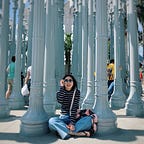MARKET & ART GALLERY
This week, I was so inspired by Deni’s speech because I used to be active in MAPPING studio in my bachelor school. This studio is initiated by Dr Jason Ho and aimed to explore the invisible beauty behind some routine landscape and enlighten us to drawing our own mapping or collective information from local residents for a civil mapping to better understand the social armature. I still remember what he reminded me all the time: You should know what your design for? And who are the protagonist of this land? This question I also raised in the last Medium. So it is really glad to require some answers from this week lectures.
Learnt from the case of Oslo and Italy, I also want to share some of my experience here to talk more about my feeling. The first one is a mapping studio I participated which named “ the art museum in a market”. That market is too traditional to have nothing common with comfort and modern like many hit projects in the world. Not only the sanitation but also the unbearable heat and humidity in the tropical city Guangzhou will keep so-called modern generation from that dark, smelly space. But thanks to the extremely low price and everlasting connection between sellers and buyers, people lived in the nearby low-income community can still afford a basic life with dignity. And the vigor of fresh, unprocessed local food and images of all kind vivid people is actually a charm to now cold metal forest. Most importantly, Dr Jason Ho opened a real gallery located just besides the market and only separated by a wall. Many fashion icons come there for meticulous photo on ins but they all detour the market every time. It was a tricky problem for us the bridge the gap between “elegance” and “common life”. At first Dr Ho COMMANDED us to company those sellers all day from stocking in the midnight to clearing up garbage after 14-h work and fashion icon too to embody the beauty chase of two crowds. Sellers always wanted to simplify their working flow and some gathering event to add some color to their repeated routine. On the contrary, visitors were more fascinated about instantaneous visual stimulus and immersed experience with rare issues. And what we want to do is to serve both crowds like a mediator, on the one side, to provoke the awareness of those sellers to cherish their vitality and emotional affiliation and inspire them to initiative more spontaneous events, on the other side, to introduce those beauty in more acceptable way to public. In that summer, we did a lot experience like installing recorded video and “peeping” TV on the both side of the wall, constructing more convenient, pretty, clean booth, printing photos of each sellers’ hands and writing a life story of each hands’ owner. At last, we held a pop-up activity called “common porridge” which means we collected a kind of food from each booth and cooked them tighter in a huge bucket of porridge and attribute to everyone, sellers and visitors.
Those sellers told me that these activity helped them find their value in this metropolis and they fist knew they can also be the contributor but not a destroyer of the city appearance and environment. And happily what we did and the proposal of a series of renewal was accepted by the local committee and they have kept some of the exhibition and activity until the explosion of COVID-19. What is more, these changes attracted some sanitation product company to improve market’s infrastructure. I cannot define this project as down-up, but I am honored to be triggering factor and mediator in this routine revival. Like Deni said in the lecture: Landscape architects do more that just plan for change, they co-create new stories of identity and community.
Honestly, another reason why I devoted so much into this project is because I lived near this market when I was a kid. All the words above are about the responsibility and duty of a landscape architect. What I want to say next is about the requirement from an actual resident. This market was used to a natural playground and Daycare for our kids. Almost all sellers are residents including our parents were migrants from villages and small towns. They understood each other and breed cohesion in order to taste family warmth like old days. Those sellers were like settled, trusty babysitters and a small gossip billboard. Residents could not only get cheap food from here but also acquire a sense of belonging when chatting and laughing. I don’t want to see these valuable images keep fading away due to week infrastructure and encroaching of urbanization.
I am so proud I was part of this great project. But sadly, I saw a news last week that this market and nearby community will be erased by a famous developer for a new shopping mall which can mitigate the economic losses brought by COVID-19. I don’t know if the affiliation and vitality will be maintained, or just stored as a museum symbolic exhibits, or even be completed forgotten by capitalism. Wish good luck.
Maybe due to this regret, this LA201 studio seems a opportunity for me explore more. But pity is still there because we cannot go there and experience the character of Marin city in person. I am not sure about the final result but now I really looking forward to it.
